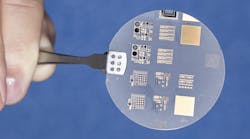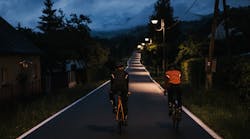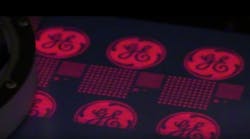For an application in LED technology, the light reflectivity and colour stability of the printed circuit board are of major importance. For this reason, a very high coverage and an intense white colour with high reflectivity values are essential for white solder resists. The photoimageable solder resists of the series Elpemer® 2491 TSW which have been available for about eight years now, provide a high yellowing resistance besides very high reflectivity values, even after reflow solder processes and additional long-term thermal loading.
We currently offer three product versions which, depending on the requirements, leave nothing to be desired for the later field of application in SSL design. Within this series, Elpemer® SD 2491 SG-TSW-R5 is the leader as far as reflectivity and yellowing resistance are concerned; a reflectivity level of approx. 95% can be reached (measured at 460 nm and with 40 µm dry layer thickness).
Elpemer® SD 2491 SM-TSW-R6-B and Elpemer® SD 2491 SG-TSW-R7 allow an even better representation of dams while exposure energies are low. Elpemer® SD 2491 SM-TSW-R6-B is the solder resist of your choice whenever a high thermal shock resistance is required. Elpemer® SD 2491 SG-TSW-R7 excels with a high-gloss surface which provides a high quality look to the printed circuit board used in SSL design applications.
Owing to their extremely high transparency along with a very good yellowing resistance, the ELPECAST® casting compounds of the series Wepuran VT 3402 KK based on polyurethane resins (UR) are used in lighting electronics and sensor technology, especially for applications where high demands are placed on optical properties, such as for potting/encapsulation of LEDs or optical sensors. The ELPECAST® casting compounds of the series Wepuran VT 3402 KK are distinguished by a very good weather resistance, outstanding UV light stability and a good thermal stability. Moreover, they offer a very high optical transparency with low optical attenuation and are resistant against water, moisture, condensation water and many chemicals, lyes, acids and oils.
The ELPECAST® Wepuran casting compound VT 3402 KK-NV can be used for underwater SSL design applications, thanks to its excellent resistance against water/hydrolisis and its high mechanical strength. Particularly suitable for encapsulating LED strips in aluminium profiles, the Wepuran casting compound VT 3402 KK-ALU provides an ideal adhesion on various aluminium base materials. Thanks to its high shore hardness, the Wepuran casting compound VT 3402 KK-ALU reaches a very good mechanical protection.
ELPECAST® Wepuran casting compound VT 3402 KK-NV-SV has achieved the best flame class V-0 in accordance with UL 94 as per UL File no. E99285 and is therefore a good choice for all lighting electronics applications where emphasis is placed on the flame retardance of the materials employed, such as emergency lightings in tunnels or buildings.
By means of the optional hazing paste and various dye-stuff concentrates, it is possible to create light-diffusing effects or a specific colouring. A very even light diffusion is reached with the opaque ELPECAST® Wepuran top coat VT 3492 LS applied as a second layer.
Various product adjustments (e.g. flexible, highly elastic, hardly flammable) allow a wide range of applications; among the typical applications there are flexible LED bars, signage, street and tunnel lighting or design elements.
The ELPECAST® Wepesil casting compound VT 3602 KK protects against corrosion caused by extreme environmental influences and aggressive media. Due to its elasticity, excellent thermal resistance of up to 200 °C and very low shrinkage pressure this silicone casting compound is particularly suitable for assemblies that are sensitive to extreme thermal and mechanical shocks.
Featuring a high optical temperature resistance of 150 °C, the colourless, crystal-clear Wepesil casting compound VT 3602 KK is a perfect solution for a use in lighting electronics applications, in particular for the coating of high power LEDs. Besides an outstanding yellowing resistance, this solvent-free 2-pack silicone elastomer reveals a very high transparency over the entire visible wavelength range, even when applied in thick layers and exposed to a permanent high temperature load. Furthermore, the Wepesil silicone casting compound VT 3602 KK is extremely resistant against weathering, UV light and tear.
Lackwerke Peters will exhibit in hall 4.0, booth A30 at Light+Building 2016.
Contact:
Sabine Thaler, International Sales and Support Coordinator - Lackwerke Peters+49 2152 20 09 946
E-mail:
[email protected]Web site:
www.peters.deLocate more packaging & optics materials vendors in the LEDs Magazine Online Suppliers Directory
Submit new products, case studies/projects, and other press releases at http://www.ledsmagazine.com/content/leds/en/addcontent.html.




